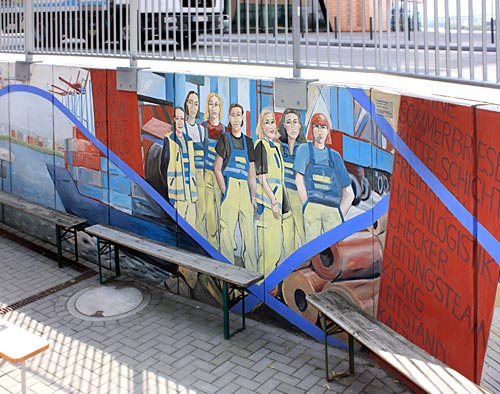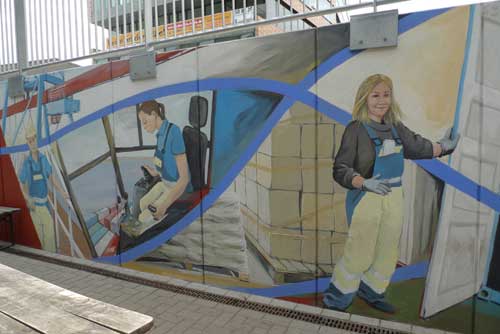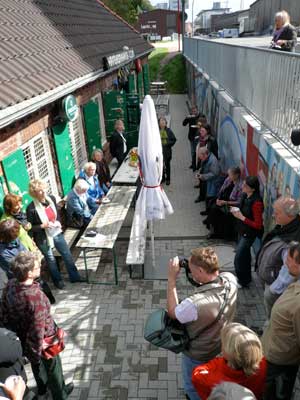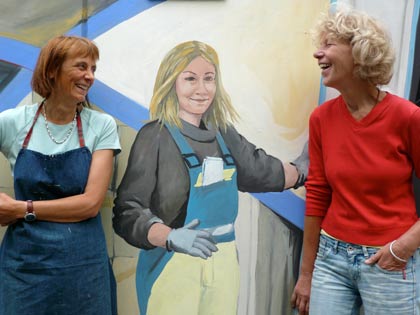Women in port logistics, 2010

"Women in port logistics" (Detail)
Große Elbstraße 276, below street level in front of the port station.
Design and realisation: Hildegund Schuster.
Sponsors: Altonaer Kulturstiftung, HHLA, R&S Baugesellschaft
Photo:: johannes Kohl ©
From the street, the mural is only visible at second glance, on the inner side of the retaining wall that serves the port station - on the underground level, you could say.(1)
It depicts what can usually only be seen - and heard - at a distance: work in progress to load and unload the container ships across the river at Burchardkai – meanwhile a no-go area for port visitors. (2)
At the same time, the mural focuses on a novelty in the working world of the port: since 2006, this is also the workplace for young women operating van carriers and gantry cranes following their training as skilled workers for port logistics with HHLA, Hamburg's port and logistics operator, founded in 1885.(3)
In 2010 when the mural was painted, ten young women were employed in operations at the quayside, a workplace hitherto reserved only for men.
This new port job for women forms the centre of the mural: seven women in the port logistics team are shown in the overalls, in casual, slightly moving and turning poses, with bracelets or earrings underlining their individual appearance.
From the middle of their group, two cobalt-blue ribbons emerge that encompass the entire mural as a symbol for water which is the element linking the trading and planning routes. In terms of composition, they connect the various mural scenes, with planning and management activities on the right and the more industrial operative work on the left.

Detail from "
Women in port logistics "
The container packing and service centre office
Photo: Hildegund Schuster ©
Four women can be seen performing planning jobs: on the far right the engineer, surrounded by construction drawings, in front of an extensive landscape of the port and its van carriers. This is followed by a three-part office scene, with the office employee surrounded by towering record files, and next to her the head of the container packing and service centre(4) . The graduate business administrator can be seen on the right, employed as commercial operations manager since 2010. Here she is depicted at the computer and on the phone, while on the left she appears once again, this time in the yellow-and-blue HHLA workwear. The artist shows this figure twice to underline the multiple requirements of her job "inside and out".
To the left of the central group picture with the logistics women, the blue ribbon leads on to the operative working world. A landscape opens up like an overture, with the artist revealing what the retaining wall conceals: the view across the river to the Burchardkai terminal. A container ship is approaching to unload its cargo.

Detail from "
Women in port logistics "
Christin in the gantry cab and on the gantry itself.
on the right: Charly at a container door.
Photo: Hildegund Schuster ©
The logistics workers are visible right next to the port landscape: here we see Charly(5) at a container door. The dark opening forms the background for posters from the Hafenbahnhof café located opposite. On the left of the picture, the ribbon leads to her colleague and gantry operator Christin, seen here in the gantry cab(6) . She uses two joysticks to manoeuvre the containers which can weigh up to 90 tonnes. This is a demanding job that needs all her concentration. She is in radio contact with her colleague the deck hand down below. Together they work as a gang or team, one down on the deck and the other up on the gantry.
The picture next to it shows the 25-year old on the gantry itself, who offers a few explanations:
The most tiring thing about the job? I'd say it's the posture. You sit there in this glass cabin, staring down through your legs to a depth of about 40 metres. To start with before I got used to it, I had to put special ointment on my shoulders in the evening to make them relax again, it's such a cramped position. I'd say there's always a certain amount of added pressure too for us to prove that women can do the job as well.
Then you have to concentrate all the time. You have to keep your eyes constantly on the container when it's moving and you have to keep your eyes on everything else too, the workers under the gantry, the supervisors, the VC operators, the ship's crew, my deck hand. Then you have to pick the container up, load it on the ship and get it precisely in position – after 3, 3 ½ hours you really start to feel it.(7)
The following scene shows Charly on the forklift truck. She's in her early 20s and, as she says, happy in her job:
Why do I work in the port? I've always been interested in men's jobs. After trying it out for a week, I'd already got the port fever. I liked the way they all worked together in a team, I just liked the whole thing, something went click and I realised yes, that's it, what's what I want to do.
It's fun working here with the men. Not once have I got here to start work and thought "I'm just not in the mood today". Negative experiences? Never. It really is so versatile. Perhaps it isn't always so great to have to start so early, and the winter can be tough, but in summer it's nice with a pleasant breeze. And yes, I love the port language, they're a bit rough around here but they mean well.(8)
The mural concludes with a historical scene, implied by the sepia shade, referring to the days when ships carried goods in bulk and were loaded and unloaded by hand. This is depicted by the rear view of two male figures heaving cargo with the assistance of barrows, the main item of equipment on the quay.
The four word strips giving structure to the composition offer a mixture of technical expressions and personal words taken from the interviews, for example: Port virus. Trousers only in the port. Short time. VC Van Carrier. Patent. Gripper. Joystick. Gantry. Kindergarten. Bitchy. Sleeping in. Half. Family planning. Middle shift. Cat. Gang. Happiness.
© Elisabeth von Dücker, 2011

Inauguration of the mural on 15/9.2010.
Photo: Brigitte Krause ©

Hildegund Schuster and Elisabeth von Dücker
in the middle: Charly at a container door.
Photo: Arndt Prenzel ©
(1) The retaining wall was made available for the mural by Altona Civil Engineering Department.
(2) Since the terror attacks on 11 September 2001, new security regulations apply in the Port of Hamburg in accordance with the ISPS Code (International Ship and Port Facility Security Code), in force since 01/07/2004 to prevent uncontrolled access to ships and port facilities.
(3) The company is owned 80% by the City of Hamburg.
(4) For the first time in 125 years, a woman works as head of department at HHLA with responsibility for operative management, working in dual leadership with her male colleague who is responsible for the operational aspects. In 2010 when the mural was painted, women accounted for 12% of altogether 3,500 employees at HHLA.
(5) In 2006, she was the first apprentice seafreight inspector at HHLA (the job was subsequently renamed as skilled port logistics worker) together with one female colleague and eight men.
(6) She was one of the first female apprentice skilled port logistics worker at HHLA.
(7) The interview with Christin C. was conducted by Elisabeth von Dücker on 27/5/2010.
(8) The interview with Charlyne E. was conducted by Elisabeth von Dücker on 08/04/2010.

